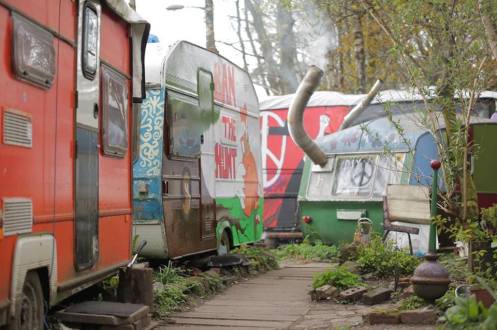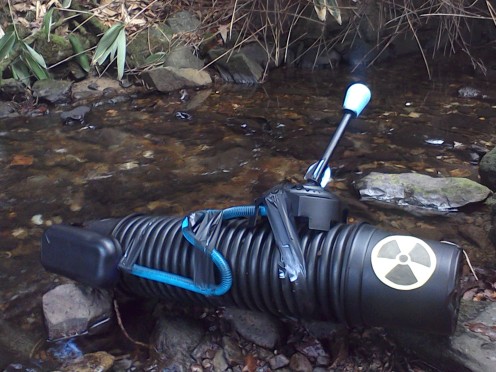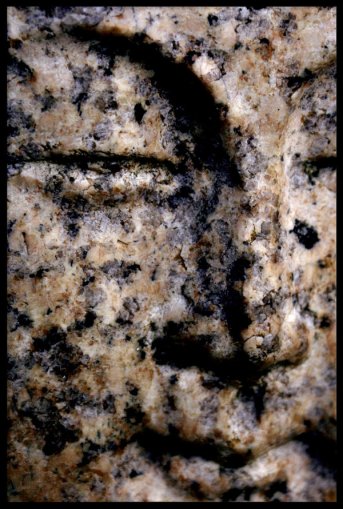 (Photo: close up of a statue of Kuan Yin, the Bodhisattva of great compassion which was atomic-bombed in Hiroshima)
(Photo: close up of a statue of Kuan Yin, the Bodhisattva of great compassion which was atomic-bombed in Hiroshima)
On Thursday the 30th of March 2017, Faslane Peace Camp (the worlds longest running active protest site and a frontline in the fight against nuclear weapons of mass destruction), was honoured to host a visit by the Hibakusha Reiko Yamada and Midori Yamada together with their translator and fellow anti-nuclear activist Shigeo Kobayashi (a member of Japanese Against Nuclear – JAN) and many visitors from SCND (Scottish Campaign for Nuclear Disarmament).
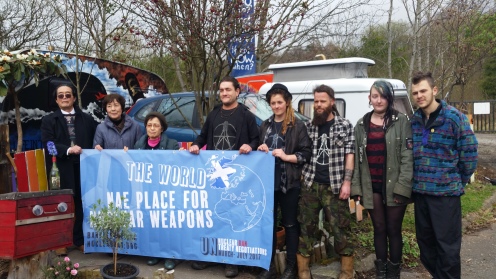
(Photo: Left to right – Shigeo Kobayashi, Reiko Yamada, Midori Yamada & Peace Campers)
It seems almost unthinkable that any living thing could survive the blast of the atomic bomb, “Little Boy”, that was dropped on Hiroshima at 8:15am, August 6th, 1945. 80,000 – 140,000 people were killed instantly and a further 100,000 seriously injured. In less than a second, “the fireball had expanded to 900 feet. The blast wave shattered windows for a distance of ten miles and was felt as far away as 37 miles. Over two-thirds of Hiroshima’s buildings were demolished. The hundreds of fires, ignited by the thermal pulse, combined to produce a firestorm that had incinerated everything within about 4.4 miles of ground zero.”
Half an hour later, a “black rain“, full of dirt, dust, soot and highly radioactive particles began falling in areas northwest of the city. Hiroshima was in ruins. Familiar landmarks were gone or unrecognizable. Buildings – even strong modern structures – had suffered significant damage, some pushed off their foundations, some gutted by fire, others utterly destroyed.
Incredibly some people did endure the blast. These survivors, (known as Hibakusha) sought relief from their dreadful injuries. But, “90 percent of all medical personnel were killed or disabled, and the remaining medical supplies quickly ran out. Many survivors began to notice the effects of exposure to the bomb’s radiation. Their symptoms ranged from nausea, bleeding and loss of hair, to death. Flash burns, a susceptibility to leukemia, cataracts and malignant tumors were some of the other effects.”
The visit by the Hibakusha to Faslane Peace Camp was part of a busy one week trip to the UK, with many meetings including a trip to both the English and Scottish parliaments. Their tour coincides with the current Nuclear ban treaty negotiations (boycotted by the English, US, French, Japanese, etc.). Reiko and Midori met with Scottish First Minister Nicola Sturgeon on Wednesday who stated that she is “totally against nuclear weapons” – a very important consideration to remember when the vote for Scottish Independence takes place between late 2018 and early 2019.
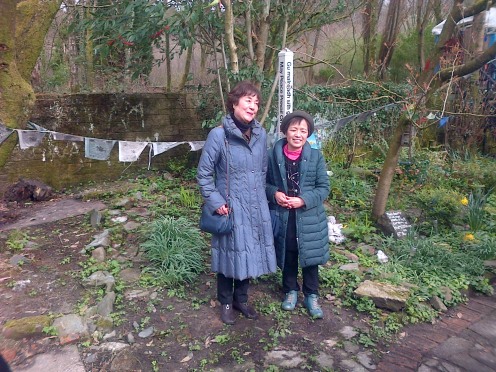
(Reiko Yamada & Midori Yamada beside the cherry tree at Faslane Peace Camp that was planted by two other Hibakusha in 1985)
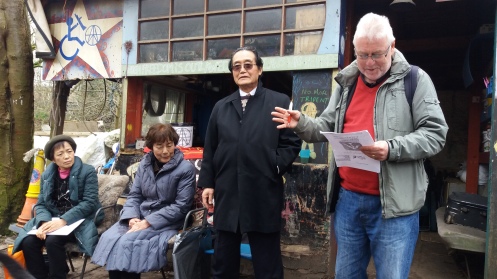
(Photo: Left to right – Midori Yamada, Reiko Yamada, Shigeo Kobayashi & SCND Chair Arthur West)
After a few introductory words by Arthur West (Chair of SCND) Reiko and Midori told their story.
Reiko Yamada started by saying that she respects Faslane Peace Camper’s continuous efforts against nuclear weapons and that she “feels so strong having seen that we actively stand against them”.
Reiko says – “I was bombed and irradiated when I was 11 years old at primary school. When the bomb dropped so many people were injured and died that you couldn’t walk through the streets because there were bodies everywhere. There were so many injured, with burnt skin dropping off and trapped beneath buildings – too many people to do anything but look.
For three days the fire raged. The people close to the epicentre were terribly burned and then came the “black rain”. People were desperate to get out, but they couldn’t.
I saw the flash, then came the blast. When I came to I didn’t know what had happened.
My father managed to stand up but he’d been cut to pieces by broken glass. My sister was really badly burned. There was no medication available so my father and sister really suffered. They were really fortunate that they could make it home – many people just disappeared and never made it home. Still, to this day, many people cannot know what happened to their family and friends who disappeared.
Any bodies that could be collected were brought to the school field and cremated – many bodies. These people suffered a lot of burns and were probably conscious for quite some time. Bodies were cremated en masse.
So we say nuclear weapons are inhuman and evil, they kill indiscriminately and make everyone collapse and die.
For the last 60 years we Hibakusha have been telling the world that nuclear weapons are evil and should not exist. But we must admit, over 15,000 nuclear weapons still exist and the nuclear nations like to make more. We keep telling them our message, that these things are terrible but the nation states are not listening, including the UK. However, we must make the effort.
Of course we like to continue to raise our voices, particularly whilst the important nuclear ban treaty discussions take place – we would like to shout out with you “NO MORE NUCLEAR WEAPONS”.
I say again that I respect your efforts – please continue hand in hand with us – please get rid of all nuclear weapons. We will go back to Tokyo and tell others about your efforts here at Faslane Peace Camp.”
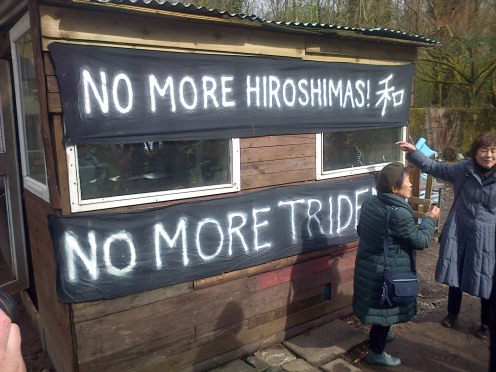
(Photo: Reiko Yamada points to the Japanese character for “Peace & Harmony”)

(Photo: Midori tells the story of her brother Jiro-chan)
Midori Yamada, 2nd generation Hibakusha had this to say:
“I also respect the people staying here at Faslane Peace Camp and keeping an eye on the submarines. My father was Hibakusha and I am the second generation. I was born in a small town on the outskirts of Hiroshima. It was a very quiet, peaceful town. I was born in 1949 but still now, I am affected by the scar of the atom-bomb – it is very deep in people’s minds. I particularly respect Reiko for visiting and spreading the Hibakusha message.
Thankfully a third atom-bomb has not been used yet. The efforts of the Hibakusha is to say never again. However, we must admit that the Hibakusha are getting older and dieing and their numbers are decreasing. So the second generation must continue to make extra effort to bring our message to the world.
Last year on August 6th, I published a book called “Jiro-chan – Story of a Hiroshima Boy” (ISBN 978-4-434-222-52-8). Jiro-chan was 13 years old when the atom-bomb was dropped. He was bright and cheerful, a bit like a clown – he would often do a funny dance when his sisters sang for example.
On August 6th 1945, Jiro-chan and his classmates were working demolishing houses (boys and girls were often involved in such work because of the war – creating fire-breaks and the like) when they saw the detonation of the atom-bomb. After the roll call he and his classmates had just started work – then there was a strong flash of light and the following percussion wave knocked Jiro-chan unconscious.
When he came to, he found himself trapped under rubble. Fire was approaching but the boys and girls trapped under the rubble couldn’t move. They encouraged each other to try to escape and cried for help – “Help us, help us please!” – but their voices weren’t heard.
Desperately struggling he finally got loose and managed to escape. The next moment the flames reared up like a giant monster and killed all his friends.
For 3 days Jiro-chan talked incessantly about the hell he’d witnessed, then he fell into a long and deep sleep.
After 3 months he regained his senses but was no longer happy and cheerful – it was as if he’d changed into someone else.
All his classmates were burned and he felt guilty that he’d survived. He had a deep scar inside.
On March 11th 2011, in the aftermath of an earthquake, was a big accident at Fukushima. Japan suffered damage from nuclear weapons at Hiroshima and Nagasaki but now it was nuclear power that had caused the problem and Jiro-chan felt bad that he hadn’t yet spoken out – “I should have informed many people about the atrocity of the atom-bombs and consoled the memory of my friends who died that day”, he said.
At 80 years old he started to talk about what happened on August 6th 1945 – he talks as if he offers prayers for his deceased friends.
Jiro-chan is my dear big brother.”
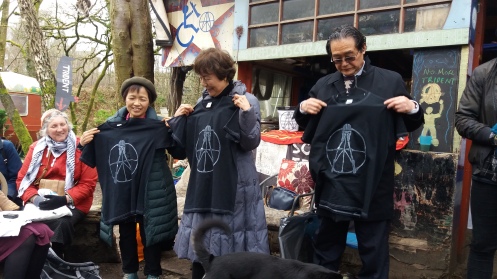
(Photo: Left to right – Midori Yamada, Reiko Yamada & Shigeo Kobayashi with their Faslane Peace Camp T-shirts)
Obviously, its been an exceptionally emotional day for us all here at Peace Camp and we owe a great debt of gratitude to Reiko Yamada, Midori Yamada, Shigeo Kobayashi and SCND – to hear these stories first hand revivified our spirits and makes us even more determined to help rid Scotland and the world of the monstrous threat of nuclear weapons of mass destruction. Also we would like to thank Midori Yamada for her gift to Faslane Peace Camp – a copy of her book “Jiro-chan – Story of a Hiroshima Boy” – even though we can’t read it without crying.
It seems somewhat ironic that a Vanguard class submarine berthed at HMNB Clyde the previous day as part of the current “Joint Warrior” exercise. The aftermath of the atomic-bombing of Hiroshima and Nagasaki is burned deep into the psyche of many Japanese people and the sheer horror of it lurks just beneath the surface of consciousness in all of us that have, at the very least, heard of this despicable act of indiscriminate mass murder – just like the Vanguard submarines malevolently lurking beneath the waves in anticipation of delivering their catastrophic payload.
As Reiko Yamada says – “Even 64 years after the bombing, we survivors still vividly remember those who desperately cried for help: their cries and memories are not gone; we are still tormented with remorse that we could not help them. Many of us also are suffering from the after-effects of radiation and from the fear of death.
I sincerely hope that people all over the world understand how a single atomic bomb could destroy a city and kill a large number of people indiscriminately and cruelly.
We Hibakusha call the atomic bombs ‘weapons of the devil’. We cannot allow even a single bomb to exist on this planet.
Nuclear weapons should be abolished to ensure a peaceful future.
The damage of atomic bombings should not be repeated.
The pain of the victims of that day must not be forgotten.
We must not allow nuclear weapons to continue to exist.
We call on you: No More Hiroshimas! No More Nagasakis! No More Hibakusha!”.
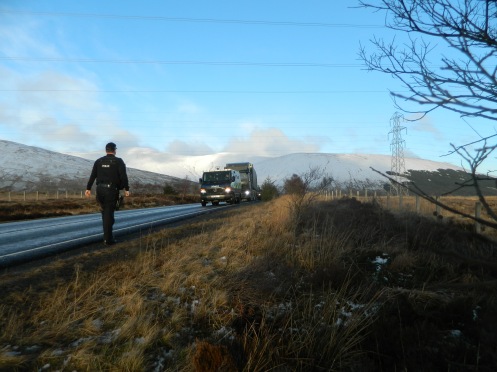
Yesterday evening at approximately 5.40pm, Peace Campers managed to bring the Nuclear Warhead Convoy to a full stop (again) on the A817, Haul Road, about a kilometre north of HMNB Clyde.

MoD police with sidearms and tasers were quick to react and as a helicopter circled above, the activists managed to leave without any arrests being made. The convoy moved off after a few minutes and is currently at RNAD (Royal Naval Armament Depot) Coulport
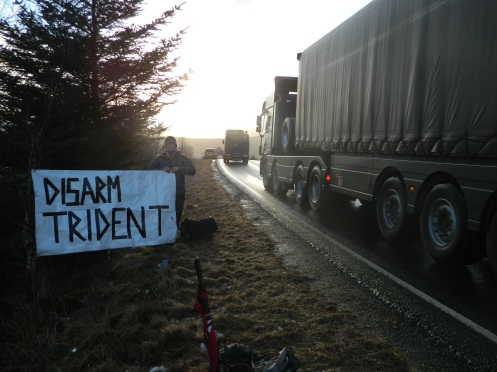
This action took place at very short notice thanks to nukewatchers alertness and accurate location reports, and the Peace Campers rapid response.

Whilst we at Peace Camp have gotten somewhat used to the threat of imminent nuclear destruction (living in Tridents shadow at one of many potential “Ground Zero” locations) we strongly suspect that most people are unaware of the danger they unwittingly face as nuclear warheads pass close by them.
The very existence of nuclear warheads is bad enough, but to transport them by road past and through major population centres is beyond belief. Within a few kilometres of five potential accident sites in Birmingham, Preston, Wetherby, Newcastle and Glasgow for example, there are a total of 2.8 million people who could be at risk. There are also 1,181 schools, 131 railway stations, 56 hospitals, 47 major roads, 12 universities and three airports. They are all potentially vulnerable to the after-effects of a convoy accident.
Throughout the country, hundreds more communities and millions more people who live along or near the convoy routes are also at risk. Yet they get no warnings, have never agreed to accept the dangers and are essentially unaware that these deadly convoys pass close by their homes and workplaces.
Furthermore, the “MoD has confessed to eight real accidents involving nuclear weapons convoys between 1960 and 1991. In response to requests under freedom of information law, it has given outline details of a further 180 safety incidents that have plagued the convoy between 2000 and 2016. The convoy has crashed, broken down and got lost. Its brakes have failed, it has leaked fuel and suffered a range of other mechanical failures. Bad luck, poor weather, human error and computer software glitches have all been to blame.”
It seems to us that it is only a matter of time before a serious incident happens, the effects and repercussions of which are too complex and frightening to imagine. This is why we seek to hinder their progress and highlight the dangers and the incidence of these lethal convoys. If the UK persists in driving its warheads up and down the country – “the risk of a catastrophic accident or attack will persist. Whether the risk is tolerable is not a judgement that should be left to the MoD alone. It is one for the millions of people through whose towns and cities the convoys pass. They have the right to decide what’s tolerable – and what’s not!”
Please note that activists from Faslane Peace Camp are acutely aware of the dangers involved when taking action against a convoy – we are exceptionally careful in both the planning and execution of any and all actions – the only people we put at risk is ourselves (unlike the MoD)! We urge members of the public to refrain from taking action against these convoys (other than campaigning, etc.) due to the obvious inherent hazards – anyone who wants to learn more about direct action can contact us through the usual channels.
For more information about the convoys and their malignant cargo see:
“Nukes of Hazard: The Nuclear Bomb Convoys on Our Roads”
Warhead Assembly, Transport & Storage

Once again an ultra-dangerous Nuclear Convoy has been spotted leaving Burghfield this morning. We’re pretty sure that this one will be travelling all the way to Coulport because of previous dummy runs and other activities by the megadeath merchants of disaster.
RNAD Coulport (Royal Naval Armament Depot Coulport) is on the eastern shore of Loch Long at the end of the B833 road on the Rosneath peninsula, and situated opposite Ardentinny on the western shore. The depot is at the end of an unclassified MoD road which begins near Garelochhead. “This wide, high quality, and substantially straight and level road was designed and constructed by the MoD to provide easy access for road convoys transporting nuclear warheads.”
The convoys normally pass London on the M25, travel on to the M1/A1 to Newcastle then either West to the A74 or North around Edinburgh. In the past the majority of Trident convoys have travelled through the centre of Glasgow on the M8.
Please let us know if you see this convoy by calling:
Faslane Peace Camp: 07376 188 216 (please keep trying if you can’t get through – the MoD regularly jam and block our signal)
Nukewatch South: 0345 4588 364
Nukewatch North: 0345 4588 365
Nukewatch Mob: 07796 226 488
For more information about Britains nuclear convoy’s see the “spotters guide“, convoy routes and warhead assembly, transport and storage.
Keep your eyes peeled and please don’t use your mobile phone whilst driving.

For over 500 years, unspeakable acts of violence and exploitation have been committed against the Indigenous Native peoples of America. In the name of profit and “development”, resource rich lands have been stolen and continue to be laid waste to fuel a profoundly sick civilisation founded on greed and lies.
We here at Faslane Peace Camp would like to express our solidarity with all the water protectors, land defenders, saboteurs, protestors and families and friends involved in these struggles – your struggle is our struggle and we stand with you in spirit as the Native Nations march on DC.
#NoDAPL.
“The ‘Dakota Access’ Pipeline (DAPL) is a $3.8B, 1,100 mile fracked-oil pipeline currently under construction from the Bakken shale fields of North Dakota to Peoria, Illinois. DAPL is slated to cross Lakota Treaty Territory at the Standing Rock Sioux Reservation where it would be laid underneath the Missouri River, the longest river on the continent.”
“It is a struggle for clean water and sustainability. It is a struggle to leave a planet in good shape for the generations to come. It is also a struggle for the sovereignty and treaty rights of the First Nations.”
Kelly Hayes puts it very well when she states that – “It is crucial that people recognize that Standing Rock is part of an ongoing struggle against colonial violence. #NoDAPL is a front of struggle in a long-erased war against Native peoples — a war that has been active since first contact, and waged without interruption. Our efforts to survive the conditions of this anti-Native society have gone largely unnoticed because white supremacy is the law of the land, and because we, as Native people, have been pushed beyond the limits of public consciousness.” (Full article here)
#StopSabalTrail.
Sabal Trail pipeline is “a fracked gas pipeline that will threaten the lands, waters (including aquifers, watersheds, rivers, springs, ponds, wetlands), our environment and flora & fauna in three states…Fracked Gas (or methane) would be transported on commuter trains and the entire system will consist of staging areas, compressor stations and areas to process and export the product. One of the plants is dangerously close to a nuclear power plant…This pipeline is just one portion of a much larger infrastructure of over 44 pipelines either being constructed now or in the planning stages all over the continent of North America”.
At least one participant in the resistance against the Sabal Trail pipeline has already been killed by the local law enforcement officers even though “no law enforcement officer was injured or fired at”.
We send our sincere condolences to all the family and friends of James Leroy Marker .
Kill pipelines not people!
- “Stand ye calm and resolute,
- Like a forest close and mute,
- With folded arms and looks which are
- Weapons of unvanquished war.
- And if then the tyrants dare,
- Let them ride among you there;
- Slash, and stab, and maim and hew;
- What they like, that let them do.
- With folded arms and steady eyes,
- And little fear, and less surprise,
- Look upon them as they slay,
- Till their rage has died away:
- Then they will return with shame,
- To the place from which they came,
- And the blood thus shed will speak
- In hot blushes on their cheek:
- Rise, like lions after slumber
- In unvanquishable number!
- Shake your chains to earth like dew
- Which in sleep had fallen on you:
- Ye are many—they are few!”
- (Percy Bysshe Shelley)
No DAPL: stand with standing rock, #NoDAPL solidarity , stand against DAPL facebook , NoDAPL Archive
Stop Sabal Trail pipeline: #StopSabalTrail , Stop Sabal Trail pipeline facebook

We’ve just been informed that the convoy that left Burghfield this morning has done a u-turn and is currently heading back down South from whence it came.
So, Nukewatchers, thanks for your help and vigilance – stay alert and watch this space for updates.
The Megadeath merchants are at it again as a Nuclear Weapons Convoy was spotted leaving Burghfield at 9:40 this morning. The Convoy consists of Warhead Load Carriers (3 to 5 massive dark green trucks), a number of MoD Police escort vehicles and a variety of Military Support Vehicles ( see ).
A Nuclear Weapons Convoy could be carrying Trident nuclear warheads, travelling empty to collect or having unloaded nuclear warheads, engaged in an exercise simulating the transport of warheads, be en route to or from an accident & emergency exercise on a military base, or transporting “Special Nuclear Materials”.
The warheads contain plutonium and other deadly radioactive materials. With each lorry carrying up to 8kg of plutonium, any accident involving an explosion or fire could lead to a radioactive plume spreading for miles, poisoning a huge area for thousands of years.
This deadly cargo could be travelling through or close to where you live ( see ). There have been a number of accidents in the past and the liklihood of a potentially catastrophic incident has grown as the traffic on British roads continues to increase. Furthermore, in 2004 the MoD changed its 50-year policy on nuclear convoys to allow making the 500 mile road trip in one go, travelling in the dark and without overnight stops: more hazardous and with higher risks to the public.
Please keep your eyes peeled and let us at FPC and Nukewatch know if you see it.
Telephone: Faslane Peace Camp: 07376 188 216
Nukewatch South: 0345 4588 364
Nukewatch North: 0345 4588 365
Nukewatch Mob: 07796 226 488
More information about the Nuclear Weapons Convoys can be found here.
Nuclear weapons are, in general, not a very commercial topic: they’re simply too horrific to provide entertainment that most would want to browse through on their free time. Even the most hilarious post-apocalyptic radiation zombie flick comes with that nasty undertone: a reminder that should a nuclear holocaust actually take place, there wouldn’t be much to laugh about anymore.
Nevertheless, the topic has brought many writers or film makers to produce excellent works of fiction in the genres of docudrama, documentary and even pure fiction: even if that fiction is based on real-life scientific facts. We here at the Faslane Peace Camp are exposed on realities of nuclear warfare on everyday basis (after all, if the doomsday button would be pushed, we’d have approximately 4-6 minutes to live anymore!), and thus felt like putting together a short, entertaining and educating list of recommendations about audiovisual takes on the topic of nuclear armament that we’d like to share with you.
1. Threads: as we are located in the UK, Threads, a 1984 British television drama, deserves to be mentioned. It’s a docudrama account of nuclear war and its effects on the city of Sheffield in Northern England, and depicts the medical, economic, social and environmental consequences of nuclear war. Threads was the first production ever to depict a nuclear winter, and has been nominated as the “film which comes closest to representing the full horror of nuclear war and its aftermath, as well as the catastrophic impact that the event would have on human culture”. It is still as up-to-date as it was then: well, maybe apart from those ghastly 80’s hairdo’s!
2. The Day After: an American television film, The Day After, got first aired 1983, bringing the likely consequences of the Cold War nuclear disaster actually breaking out into the living rooms of large audiences. Before the film premiered, viewers were warned of “graphic and disturbing scenes”, and parents were encouraged to watch together and discuss the issues of nuclear warfare with their kids after the film. Television channel had hotlines with counsellors standing by. The realistic portrayal of nuclear war received praise. President Reagan watched the film before its screening, and wrote in his diary that it was “very effective and left me greatly depressed,” and that it changed his mind on the prevailing policy on a nuclear war. Four years later, the Intermediate-Range Nuclear Forces Treaty was signed and in Reagan’s memoirs he drew a direct line from the film to the signing: “Don’t think your movie didn’t have any part of this, because it did.”
3. Command and Control: the 2016 documentary Command and Control brings us the long-hidden story of an horrific accident at a Titan II missile complex in Damascus, Arkansas in 1980. Based on the book by Eric Schlosser, it reminds you of an ancient golden rule: fiction will always play a second fiddle to reality when it comes to true horrors. The case history simply exposes the terrifying truth about the management of America’s nuclear arsenal and shows what can happen, in reality, when the weapons built to protect us threaten to destroy us. Documentary presents us the chain of events that caused the accident and the efforts to prevent the explosion of a ballistic missile carrying the most powerful nuclear warhead ever built by the United States – a warhead 600 times more powerful than the bomb that destroyed Hiroshima. Living next to the Trident nuclear deterrent brings this one uncomfortably close to home, that much we can say!
4. On the Beach: and speaking of HMNB Clyde, a.k.a. Faslane Naval base and its Vanguard nuclear subs, we feel that On the Beach is a work of (sort of) fiction that needs to be mentioned: after all, in its center are a crew of an Los Angeles-class submarine, on station following a nuclear exchange. Based on the 1957 novel by Nevil Shute, both movies (the 1959 original and the 2000 remake) update the setting of the story to the film’s then-future of 2005. As a mini-serie this is a relatively lengthy one, but delivers some impressive images of the aftermath of the nuclear holocaust: the submarine crew walking through the ruins of Anchorage discovering how the people there committed suicide en masse, and a educative periscope tour of the ruins of San Francisco.
5. Akira: as a closing clip, we choose a true classic on many levels, Akira. At the end of the film, a white mass begins to envelop Neo-Tokyo, its swirling winds engulfing the city, swallowing it and leaving nothing but a skeleton of a city. The bombings of Hiroshima and Nagasaki were and are a national trauma for the Japanese. Part of the healing process still means returning to it in literature, music and art. The lasting images of the firebombings and the nuke bombs are visible, for example, in the works of Osamu Tezuka and his successor, Hayao Miyazaki. Both witnessed the of the bombings at the end of the war. Akira is just one of the many adaptations and takes on these marks of horrific history of nuclear weapons.
Most people go to the seaside and Loch shores for bird watching or just general pleasant sea views. We here at the Faslane Peace Camp are forced to set our eyes also on the sort of views that should’ve never started to exist or should’ve gotten scrapped a long time ago.
From February we share these selected clips with you, dear viewers. On most of the shots you see an Astute class sub, one from the hunter-killer breed that is not carrying nuclear warheads, but would be protecting those four Vanguard class subs who do.
Lately the media has been bursting with news about lots of sub problems the Royal Navy is struggling with (serves them right, right? – it’s just that you folks are footing the ongoing, ever increasing cost): the Trident misfiring case, the old maintenance issues of the Vanguards and, as the latest catch, the little fact that even the new and improved Astute’s are not exactly in a seafaring condition. Though, this should not come as that big of a surprise: already, back in 2013 the problems with the cost and delivery of these new nuclear-powered Astute subs were set out in uncompromising detail in a report published by the National Audit Office .
Feel like giving us a hand with nuke sub spotting? You’re welcome. We offer what you need: from binoculars to kayaks. The rest is up to you. 😉
In 35 years many bits and pieces of the camp infrastructure have risen, fallen and risen again. One of the most characteristic parts of the Peace Camp infrastructure are probably the caravans, which keep on housing the arriving anti-nuclear activists. And we love these caravans, we love them to bits. Literally. Some of the vans are almost as old as the camp itself: and no matter how much love and carpentry you shower them with, eventually they retire themselves.
Currently, we are renewing many parts of the camp infrastructure and building many things totally new. And this is something we need YOUR help with! You are most welcome to join us in direct activities against the nuclear madness: but there are many other ways to help this struggle, too.
Thus: we are looking for caravans. While facing the need to demolish some of the most worn-out and well-loved caravans, we need to be able to offer new accommodation for both, visitors and residents.
Don’t worry, we’re not too picky: as long as there’s no mold, rot, termites and other not-that-easily-fixable problems, we’re more than happy to come and check every caravan available. With a little bit of carpentry and fixing you can practice small miracles. Outdated interiors and little toothmarks of time are nothing to be worrying about: do not hesitate to give us a ring or to drop an email about caravans you’ve got consuming space there in a garage, nesting at the back of your auntie’s garden, waiting to be replaced by that new and updated model your family has set eyes on.
We will take them for free or agree upon a suitable price: just contact us, and we’ll sort it from there. Help us to head towards the next phase of Peace Camping!
In January we learned some funky facts about the rather tragicomical test-firing of the UK’s Trident II D5 ballistic missile in June last year: yes, that one where the missile decided to head to an opposite direction than intended and everybody did their best to cover the mess up.
Yesterday we learned that not only the four ageing Vanguard class nuke subs are in wee bit of a trouble with all this maintenance stuff, but also Britain’s fleet of seven Astute class “attack” subs are “not on active operations“. These new and improved hunter-killer subs are not carrying nuke missiles, but would be the ones protecting the Vanguards which do.
Instead of simply reminding that nuclear warfare is a load of lethal bollocks and ridiculing the Royal Navy beyond recognition over it’s falling-apart-fleet-of-rust-buckets, we decided to get pro-active and offer a helping hand! The Faslane Peace Camp did some calculations, careful crafting and here we go with out masterpiece: HMS Hopeful, from new and improved Peacekeeper class!
In comparison to Vanguards, Astutes, and such, the first sub from the new Peacekeeper class brings in a few improvements: a) she actually, you know, functions, and b) this scientific masterwork doesn’t put all life on Earth to imminent danger. We invite you to pay closer attention to some fine details:

The ammo system is an environmentally friendly edition and operates simply with, well, pedal and air force.
But perhaps we shouldn’t be so hard o the poor Royal Navy. After all, the French nuclear giant EDF seems to be having some trouble with their nuke products, too. On 9th of Feb. an explosion took place in a nuclear power plant near English Channel after fire in reactor engine room.
“They wanted to replace the aging Trafalgar Class rust buckets with these Astutes, and lo and behold, now them Trafalgars seem to be the only ones that, to an extent, manage to stay in one piece. What are they gonna do next, bring out the U-571?” laughs a local supporter who wishes to remain anonymous (after all, the Royal Navy or MoD police officers might not appreciate being laughing stocks).
Maybe even the last stubborn relics should finally get the hint. With disability of producing a non-explodable nuke plant and doomsday weapons able to hit their targets we could finally come to a sensible conclusion of scrapping the nuclear madness, both civilian and military ones, and head towards a more sustainable, humane times.
And of course: as the HMNB Clyde (or Faslane naval base, on more common terms) is in bit of a trouble with finding enough staff and keeping its subs of all sorts in one piece: should anyone be looking for a good momentum to come in and give them some extra work in dealing with directly active nuke criticism, this might just be the time you want to pack up and arrive here?








